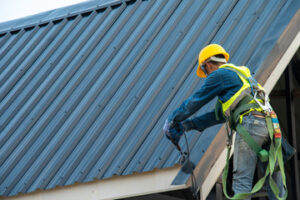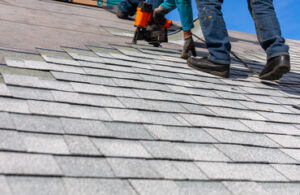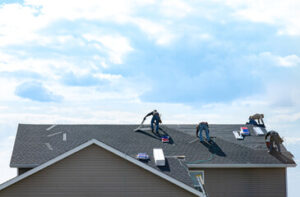Whether your roof needs repairs to replace a few missing shingles or patch a leak, the first step is always a thorough inspection by a qualified roofing contractor. This will help you understand the scope of the repair and the condition of the existing roof system.

If the damage is isolated and your roof is relatively young, repairs may be a better choice than replacing the entire roof. Visit https://www.bostonroofingco.com/ to learn more.
Dark stains, streaks, and missing or curled shingles are warning signs that roof repair is needed. Similarly, damaged flashing around chimneys and vents can allow water into your home. Regularly inspecting and repairing these areas will help protect your home from unexpected moisture intrusion, and costly roof repairs down the road.
For any work that needs to be done along the edge of a roof, safety measures must be in place to ensure workers are protected from fall hazards. Depending on the size of the roof, this may include the use of a scaffold or man lift.
Embedding the reinforcement scrim into the coating application provides an additional layer of protection. It also helps to eliminate substrate failure as an exclusion in your warranty.
Drainage
Drainage is essential for protecting the structure of your home and property. Water that pools on the roof surface puts a strain on the shingles and the building frame, causing sagging, cracking, and eventual structural failure. Standing water also promotes mold and mildew growth, which can rot the roofing materials and contaminate the living environment. This creates health risks for building occupants and requires expensive remediation.
Roof repair services that address drainage issues can help protect your home from expensive damage and maintain a healthy living environment. A professional roofer will inspect the shingles, gutters, downspouts, and drains for signs of trouble, such as clogs or improper slopes that hinder water flow. Prompt repairs to these components can prevent costly problems down the line, such as structural damage, leaks, and water damage to the interior of your home.
Roofing materials degrade when exposed to water for extended periods of time, especially in humid environments. Poorly-draining flat roofs may develop a layer of spongy, wavy insulation, while asphalt shingle roofs can deteriorate, sag, and crack. Water that drains too slowly saturates soil at the base of the house, and may seep into basement walls, weakening them or causing foundation cracks. This can cause expensive repairs to the foundation, basement, and exterior walls of your home.
Neglecting a roof drainage system can also lead to the formation of ice dams. These occur when snow melts unevenly and freezes at the edge of your roof, pushing melted water back under shingles. This can lead to severe leaks, rot, and mold.
A good roofing contractor will check for a proper incline on flat roofs and make sure the drains are functioning properly. They will also check gutters and downspouts to ensure they are free of debris, and that the incline is directing water away from the building. This will help prevent overflow and ponding, which can push water into areas it shouldn’t go.
A properly functioning roof should dry in 48 hours after a rainstorm, assuming the weather conditions are favorable. If your roof is older than 15 years, or has a few missing shingles, it may need roof repair to avoid further problems.
Energy Efficiency
A home’s roof acts as a critical barrier, regulating indoor temperatures and reducing unwanted energy exchange with the outside environment. However, a poorly maintained roof can reduce energy efficiency and increase energy bills. Roof repair, mainly sealing cracks and upgrading materials, prevents this energy loss and rebalances the load on heating and cooling systems, saving money over time.
Irregularities in shingles and insulation, as well as blocked or inadequate venting, cause significant energy waste. Fortunately, these problems are easy to resolve with proactive repairs. A roofing contractor can identify and repair these issues, helping you save on energy costs and maintain optimal indoor comfort.
Cracks and gaps in a roof allow warm air to escape in winter and hot air to enter in summer, making it harder to regulate indoor temperatures. These issues create an unnecessary burden on heating and cooling systems, resulting in increased energy consumption and higher utility bills. Proper ventilation prevents heat and moisture buildup, reducing the workload on air conditioning systems. During roof repair, contractors can inspect and improve ventilation systems, addressing issues like blockages, moisture accumulation, or insufficient venting.
Whether it’s caused by a recent storm or general wear and tear, a few missing or cracked shingles can lead to water leaks and structural damage. Regular roof inspections can detect these issues and address them before they escalate. A professional can replace the damaged shingles and reseal the roof, protecting the interior of the home and extending the lifespan of the roof.
If you’re looking to upgrade your home’s energy efficiency, solar panels are an excellent choice. They’re a greener alternative to traditional energy sources, reducing your carbon footprint and providing sustainable financial benefits. However, it’s important to understand the relationship between solar panels and your roof. Regular maintenance and timely repairs are essential for the proper performance of your rooftop installation. Without these, you’ll need to invest in more expensive repairs or premature roof replacement. Additionally, regular upkeep extends the lifespan of solar panels and enhances their overall performance, maximizing your investment.
Durability
Roof repair provides a layer of durability to prevent further damage to the underlying structure and improve a home’s resistance against leaks. The techniques used by professional roofers include repairing damaged areas and coating the entire surface with an elastomeric sealant. These solutions reduce future maintenance costs and extend the lifespan of the roof.
Durability also extends to the materials and components that are installed as part of a roof repair project. Weather conditions and sun exposure are significant influencers on a roof’s lifespan, but durable roofing options help protect against long-term wear and tear. The choice of roofing materials is important in determining a roof’s longevity, and knowing the life expectancy of the various types of roofing systems helps homeowners plan for future repairs.
A sagging roof is an indication of a structural problem that requires immediate attention. In addition, a sagging roof can lead to water leaks and rot that compromise the integrity of the underlying structure. Regular inspections by a professional roofer help prevent these problems and identify potential issues.
Indicators of a need for roof repair may include patchy shingles, water stains on the ceiling or in the attic, or localized leaks. The location and nature of the leak can help determine if it is due to a single issue, such as a blown off or missing shingle, or the result of a larger issue, such as a failing roof system.
A thorough inspection by a qualified roofer can identify the extent of damage and recommend a solution. Generally, roof patches are a good option for small leaks and other minor damage, but more extensive or widespread issues require a more permanent solution. A roofer can replace the entire roof or install a metal or membrane to ensure watertight integrity. Using a patch kit, the roofer can prepare the affected area by cleaning and clearing away any rust or debris. The patch is then cut to size and inserted into the hole, securing it with roofing screws and sealing the edges.




